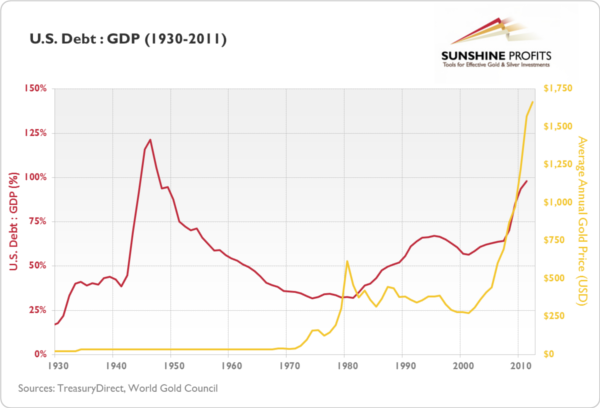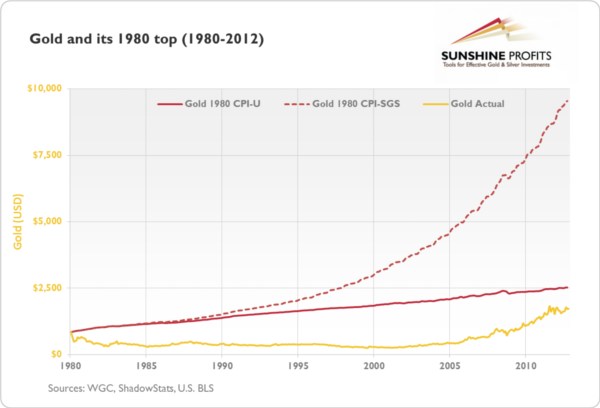Does Gold Make Sense If the Dollar Does Not Collapse?
Przemyslaw Radomski, CFA | Dec 13, 2012 06:02AM ET
We follow up on our essay on gold as a hedge against such a possibility.
The common misconception, already pointed out, is that the collapse of the dollar is “imminent,” “sure” or “certain.” It’s not. Just as nobody knows what will happen in the future, nobody can say that the dollar will collapse for sure. And, even if somebody is personally quite convinced that the dollar is heading for the gutter, there’s absolutely no certainty when this will happen.
Even though the number of borrowed dollars has never been higher, current debt levels in relation to GDP are not at their historical highs. As of 2011, the U.S. debt to GDP ratio stood at 98.1%. The chart below shows that, in terms of debt, the U.S. economy has already been here.

In 1946, one year after the end of WWII, the debt to GDP ratio stood at 121.3%, its highest historical level so far. Obviously, the economic conditions after WWII were quite different than the conditions we have today, but the point is that in the past, the U.S. economy was able to recover from enormous debt levels. It is still possible that it will recover from all the debt the QEs have been amassing.
The implosion of the dollar and the global currency system is quite an unlikely event. If the widely discussed collapse of the dollar never materializes, in spite of the current debt levels, can it still be a good idea to hold on to gold?
It can, particularly if you consider that we are in a bull market and there are no clear indications that this market is to end any time soon. What is more, we haven’t seen a pronounced phase of exponential growth in prices, nor have we experienced the craze of the third stage of the bull market when everybody and their brother would jump at the opportunity to buy precious metals. We provide some comparisons in the chart below.

The yellow line represents the price of a troy ounce of gold between 1980 and 2012. The solid red line is the price of gold during the 1980 top ($850) corrected for the official U.S. inflation numbers and the dashed red line is the same price corrected for inflation numbers as they would have been calculated prior to a change in the methodology of inflation calculation (accidentally, this change coincides with the 1980 top).
In other words, the solid red line shows you how expensive gold would have to be to buy you the same things it bought in 1980 if you followed official data. The dashed line shows you how expensive gold would have to be if you took into account unofficial data.
As of the end of November 2012, according to official U.S. Bureau of Labor Statistics, gold would have had to trade at $2,527.24 to match the 1980 top. It traded at $1,719.00 which could imply that if the top were to be seen in the nearest future (very unlikely), gold could shoot up by 47.0%.
Taking a look at the unofficial data, gold would have to appreciate to $9,548.34 to be able to buy you the same amount of goods it did in 1980. Compared to the price of $$1,719.00 (end of November 2012), this would mean an appreciation of 455.5% (!). The target of $10,000 without the collapse of the dollar seems far-fetched, but even if the unofficial numbers exaggerate the inflation, and the latter has been so far somewhere between the official and unofficial numbers, this would mean a possible price for gold beyond $2,500.
If the bull market continues throughout the next years and plays out similarly as the previous one without the collapse of the dollar, we see the gold-going-to-$2,500 scenario as a worst case one and the gold-going-to-$10,000 as an unlikely (but possible) best case scenario. $2,500 might be a worst case scenario because:
- The longer it takes for the bull market to end, the higher the nominal target will be (because of the inflation).
- The bull market of 1980 was limited to the U.S. and Western Europe. Right now, there is a much broader audience now to participate in the bull market. For instance, countries from Central and Eastern Europe, as well as China and India.
- Technological advances have made the information flow considerably easier than in 1980. It is easier now to enter the market quickly. To reverse one’s position is just a matter of seconds or minutes rather than hours which suggests that the volatility and price moves in the end phase of the bull market may be substantial.
, if the 1980 top is anything to go by, then even if there’s no dollar collapse ahead of us, it still may be a good idea to be invested in precious metals.
Trading in financial instruments and/or cryptocurrencies involves high risks including the risk of losing some, or all, of your investment amount, and may not be suitable for all investors. Prices of cryptocurrencies are extremely volatile and may be affected by external factors such as financial, regulatory or political events. Trading on margin increases the financial risks.
Before deciding to trade in financial instrument or cryptocurrencies you should be fully informed of the risks and costs associated with trading the financial markets, carefully consider your investment objectives, level of experience, and risk appetite, and seek professional advice where needed.
Fusion Media would like to remind you that the data contained in this website is not necessarily real-time nor accurate. The data and prices on the website are not necessarily provided by any market or exchange, but may be provided by market makers, and so prices may not be accurate and may differ from the actual price at any given market, meaning prices are indicative and not appropriate for trading purposes. Fusion Media and any provider of the data contained in this website will not accept liability for any loss or damage as a result of your trading, or your reliance on the information contained within this website.
It is prohibited to use, store, reproduce, display, modify, transmit or distribute the data contained in this website without the explicit prior written permission of Fusion Media and/or the data provider. All intellectual property rights are reserved by the providers and/or the exchange providing the data contained in this website.
Fusion Media may be compensated by the advertisers that appear on the website, based on your interaction with the advertisements or advertisers.